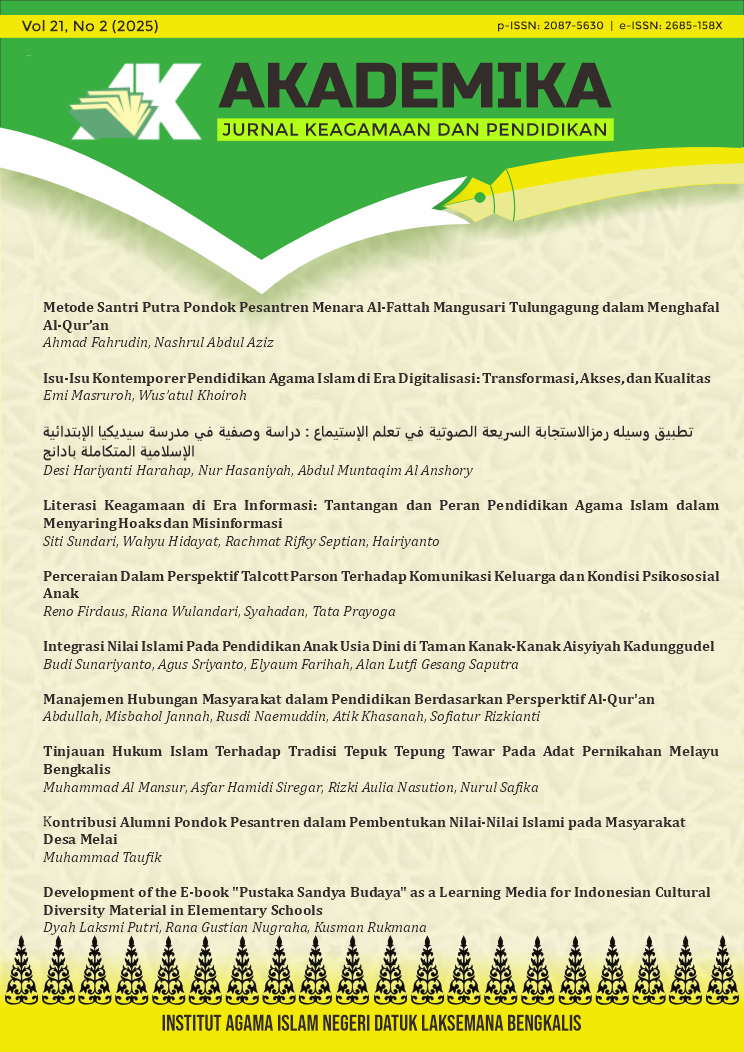تطبيق وسيله رمزالاستجابة السريعة الصوتية في تعلم الإستيماع : دراسة وصفية في مدرسة سيديكيا الإبتدائية الإسلامية المتكاملة بادانج
DOI:
https://doi.org/10.56633/jkp.v21i1.1092Keywords:
Audio Media, QR Code, Istima', Arabic Language Learning, Elementary School StudentsAbstract
This study aims to describe the application of QR Code-based audio media in learning Arabic istima' (listening) at SD IT Cendikia Kota Padang. The background of this research departs from the need for learning media that is effective, fun, and encourages the learning independence of elementary school students. Using a descriptive qualitative approach, data were collected through observation, interviews, and documentation, involving 26 fourth grade students, Arabic teachers, and parents. The results showed that audio media accessed through the QR Code in the textbook made it easier for students to access auditory material, improve phonetic skills, expand vocabulary, and encourage independent repetition outside the classroom. 70% of students were able to imitate pronunciation well, and 40% showed initiative to learn without teacher direction. Parents also claimed that it was easier to accompany their children to learn through this media. The findings of this study are supported by the theories of Multimedia Learning (Mayer), learner autonomy (Holec), and social constructivism (Vygotsky). This study recommends expanding the use of QR Code-based audio media in Arabic language learning to strengthen istima' skills and build synergy between school and family.
References
Apriliani, Putri, Aceng Jaelani, and Misbah Binasdevi. “PENGEMBANGAN MEDIA PEMBELAJARAN KOMIK BERBASIS QUICK RESPONSE ( QR ) CODE PADA PELAJARAN AKIDAH AKHLAK” 9 (2024): 1–12.
Fitriani, Namiyah. “تحسين تعلم اللغة العربية : تقييم كتاب ‘ تعليم اللغة العربية’ للصف العاشرفي سياق K 13” 20, no. 2 (2024): 204–17.
Handayani, Fajar Anisa, and Titik Haryati. “Pemanfaatan Media Pembelajaran QR-Code Sebagai Upaya Implementasi Pendidikan Sesuai Kodrat Zaman KHD Di SMP Negeri 6 Semarang.” Jurnal Ilmiah Profesi Pendidikan 9, no. 2 (2024): 809–15. https://doi.org/10.29303/jipp.v9i2.2180.
Hazmi, Nahdatul, Nurhizrah Gistituati, and Mega Iswari. “The Effect of Video Learning Media on Communication Skills and Creativity of Students of The History Study Program of Stkip Yayasan Abdi Pendidikan” 3, no. 1 (2025): 1483–92.
Husna, Nurul, Indrawati, and Amri. “Perancangan Mobile Learning Bahasa Arab Menggunaan QR-Code,” n.d., 40–47.
Insani, Hilda Nurul. “Strategi Efektif Untuk Meningkatkan Keterampilan Berbahasa Pada Anak Usia Dini Pemalu Melalui Pendekatan Teori Zona Perkembangan Proksimal ( ZPD ) Vygotsky,” no. 2 (2025): 1–14.
Kusumadewi, Indriani Permata, Itsnaini Muslimati Alwi, and Sanjaka Yekti. “Efektivitas Media Audio Visual Dalam Keterampilan Istima ’ Di Mi Muhammadiyah Gembuk 1” 4, no. 2 (2022): 1–9. https://doi.org/10.47435/naskhi.v4i2.1222.
Lestari, Asdini Indah, Yacobus Ndona, and Ibrahim Gultom. “Pengembangan Sosial Emosional Siswa SD Dengan Perspektif Konstruktivisme Sosial Oleh Lev Vygotsky” 7, no. November (2024): 12441–45.
M. Aurah, Catherine. “The Effects of Self-Efficacy Beliefs and Metacognition on Academic Performance: A Mixed Method Study.” American Journal of Educational Research 1, no. 8 (2013): 334–43. https://doi.org/10.12691/education-1-8-11.
Miasari, Rahmalia Syifa, Cory Indar, Pratiwi Pratiwi, Purwoto Purwoto, Unik Hanifa Salsabila, Ulfiyana Amalia, and Syaiful Romli. “Teknologi Pendidikan Sebagai Jembatan Reformasi Pembelajaran Di Indonesia Lebih Maju.” Jurnal Manajemen Pendidikan Al Hadi 2, no. 1 (2022): 53. https://doi.org/10.31602/jmpd.v2i1.6390.
Radisti, (, Ananda Hanum, Ira Mirawati, Kismiyati El Karimah, and Radisti Ananda Hanum. “Mengembangkan Pesan Whatsapp Tentang Edukasi Mindful Parenting Dengan Prinsip Cognitive Theory of Multimedia Learning.” AGUNA: Jurnal Ilmu Komunikasi 4, no. 01 (2023): 75. http://ejournal.amikompurwokerto.ac.id/index.php/AGUNA75.
Salamah, Ummu, and Muassomah Wibisono. “Al Mi ’ Yar : Jurnal Ilmiah Pembelajaran Bahasa Arab Dan Kebahasaaraban The Use of QR Code-Based Arabic Ewan Textbooks in Learning Mah ā Rah Kal ā M” 7, no. 2 (2024): 836–42.
Taufik, and shofiyah wardatul Jannah. “Penggunaan Media Audio Visual Dalam Pembelajaran I Stima ’” 02, no. 1 (2024).
Tuan, tran van. “LEARNER-CENTERED APPROACH IN TEACHING METHODS,” no. 3 (2011): 2011–13.
Wijayanto, Adi, bea hana Siswati, Yulianti, and muhammad syamsul Taufik. Nyalakan Semangat Kompetensi Melalui Peningkatan Sdm Unggul, 2022.
Downloads
Published
Issue
Section
License
Copyright (c) 2025 Desi Hariyanti Harahap, Nur Hasaniyah, Abdul Muntaqim Al Anshory

This work is licensed under a Creative Commons Attribution-NonCommercial-ShareAlike 4.0 International License.
Authors who publish with this journal agree to the following terms:
- Authors retain copyright and grant the journal right of first publication with the work simultaneously licensed under a Creative Commons Attribution-ShareAlike 4.0 International License. that allows others to share the work with an acknowledgement of the work's authorship and initial publication in this journal.
- Authors are able to enter into separate, additional contractual arrangements for the non-exclusive distribution of the journal's published version of the work (e.g., post it to an institutional repository or publish it in a book), with an acknowledgement of its initial publication in this journal.
- Authors are permitted and encouraged to post their work online (e.g., in institutional repositories or on their website) prior to and during the submission process, as it can lead to productive exchanges, as well as earlier and greater citation of published work (See The Effect of Open Access).






